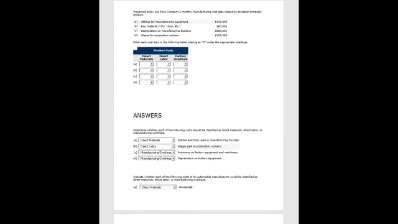Content
- Managerial Accounting
- How is the cost of goods sold classified in financial statements?
- Accounting Principles II
- Inventory Cost Method
- Problem-13: Managerial Accounting
- Chegg Products & Services
- What Does Cost of Goods Sold Tell You, and Why is it Important?
- Master Your COGS: Learn Cost of Goods Sold Formula (
Periodic physical inventory and valuation are performed to calculate ending inventory. Confidently launch your product on a budget with our easy-to-use cost calculator. Keisha Tombert , the bookkeeper for Washington Consulting, a political consulting firm, has recently completed a managerial accounting course at her local college. Instructions Indicate the missing amount for each letter (a) through (i).

The cost of goods manufactured for the period is added to the finished goods inventory. To calculate the cost of goods sold, the change in finished goods inventory is added to/subtracted from the cost The Cost Of Goods Manufactured Schedule of goods manufactured . However you manage it, knowing your COGS is critical to achieving and sustaining profitability, so it’s important to understand its components and calculate it correctly.
Managerial Accounting
You also use gross profit to calculate your gross profit margin, which is a metric that measures the financial health of your business. Manufacturing costs refer to any costs incurred during the process of manufacturing a finished product and include the 1) cost of raw materials, 2) direct labor, and 3) overhead costs. It requires a company to keep complete and accurate records for the GAAP calculations reported on financial statements and, separately, to support a tax return.
- This means it cost the company $230,000 to manufacture all the goods that were completed during the period.
- Instead, they rely on accounting methods such as the first in, first out (FIFO) and last in, first out (LIFO) rules to estimate what value of inventory was actually sold in the period.
- Notice the relationship of the statement of cost of goods manufactured to the income statement.
- So, in this example, the Cost of Goods Manufactured during the period is $230,000.
- Even though all of these industries have business expenses and normally spend money to provide their services, they do not list COGS.
Each of the components that go into total manufacturing cost have to be considered separately. All of the above can become exponentially more complicated when volumes and product lines increase. For companies with many SKUs, the best approach to calculating COGS will be a robust accounting system that’s tied to inventory management. For businesses with under $25 million in gross receipts ($26 million for 2020), there are some exceptions to the rules for inventory, accrual accounting and, by extension, COGS. There are many different methods for valuing inventory under GAAP.
How is the cost of goods sold classified in financial statements?
The beginning WIP is the value of all unfinished products that carried over from the previous accounting period. The ending WIP, on the other hand, comprises the remaining manufacturing costs after deducting the value of goods finished within the period. It’s easy to calculate direct labor costs for a manufacturing facility.
- Indirect costs to be included for tax purposes include rent, interest, taxes, storage, purchasing, processing, repackaging, handling and administration.
- However, production software such as a capable manufacturing ERP system continuously tracks all manufacturing costs and inventory movements and calculates both COGM and COGS automatically.
- At this point, you have all the information you need to do the COGS calculation.
- Gross profit is a profitability measure that evaluates how efficient a company is in managing its labor and supplies in the production process.
It’s an ideal method for mass-produced items, such as water bottles or nails. Instructions Compute cost of goods manufactured Prepare an income statement through gross profit Show the presentation of the ending inventories on the… The process and form for calculating the cost of goods sold and including it on your business tax return are different for different types of businesses.
Accounting Principles II
Calculating COGS can be challenging, especially as the business becomes more complex; an accounting system integrated with inventory management software can reduce the effort required and ensure accuracy. And regardless of which inventory-valuation method a company uses—FIFO, LIFO or average cost—much detail is involved. As evidenced by the COGS formula, COGS and inventory go hand-in-hand.

Unlike COGS, operating expenses (OPEX) are expenditures that are not directly tied to the production of goods or services. The other half of the COGM formula accounts for the work in process or WIP Inventory. WIP is a current asset in the company’s balance sheet and represents the total value of all materials, labor, and overhead of unfinished products.
COGM is thereby the dollar amount of the total costs incurred in the process of manufacturing products. The COGM formula starts with the beginning-of-period work in progress inventory (WIP), adds manufacturing costs, and subtracts the end-of-period WIP inventory balance. When inventory is artificially inflated, COGS will be under-reported which, in turn, will lead to a higher-than-actual gross profit margin, and hence, an inflated net income. It should be current Work in Progress material + manufacturing cost. To calculate Work in Progress inventory, use similar calculation with Raw Material inventory above.
- The beginning work in progress (WIP) inventory is the value of goods recorded as WIP at the start of the financial year or accounting period.
- Once the manufacturing costs have been added to the beginning WIP inventory, the remaining step is to deduct the ending WIP inventory balance.
- Using the FIFO method will result in a lower cost of goods sold in times of rising costs because you’re calculating COGS based on lower-cost inventory.
- He is especially interested in environmental themes and his writing is often motivated by a passion to help entrepreneurs/manufacturers reduce waste and increase operational efficiencies.
The cost of goods manufactured schedule is used to calculate the cost of producing products for a period of time. The cost of goods manufactured amount is transferred to the finished goods inventory account during the period and is used in calculating cost of goods sold on the income statement. Note how the statement shows the costs incurred for direct materials, direct labor, and manufacturing overhead. The statement totals these three costs for total manufacturing cost during the period. When adding beginning work in process inventory and deducting ending work in process inventory from the total manufacturing cost, we obtain cost of goods manufactured or completed. Cost of goods sold does not appear on the cost of goods manufactured statement but on the income statement.
Problem-13: Managerial Accounting
You can do it on a spreadsheet or have your tax professional help you. COGS only applies to those costs directly related to producing goods https://kelleysbookkeeping.com/ intended for sale. The IRS allows you to deduct the cost of goods that are used to make or purchase the goods you sell in your business.
Your inventory at the beginning of the year, recorded on January 1, 2022, is $20,000. At the end of the year, on December 31, 2022, your ending inventory is $6,000. The following data were taken from the records of Clarkson Company for the fiscal year ended June 30, 2020 Instructions Prepare a cost of goods manufactured schedule (Assume all raw… Bell company, a manufacturer of audio systems, started its production in October 2020. Fort the preceding 3 years, Bell had been a retailer of audio systems. So, in this example, the Cost of Goods Manufactured during the period is $230,000.
Chegg Products & Services
You most likely will need a tax professional to calculate COGS for your business income tax return. But you should know the information needed for this calculation, so you can collect all the information to include in this report. Once the manufacturing costs have been added to the beginning WIP inventory, the remaining step is to deduct the ending WIP inventory balance. LIFO is where the latest goods added to the inventory are sold first.






